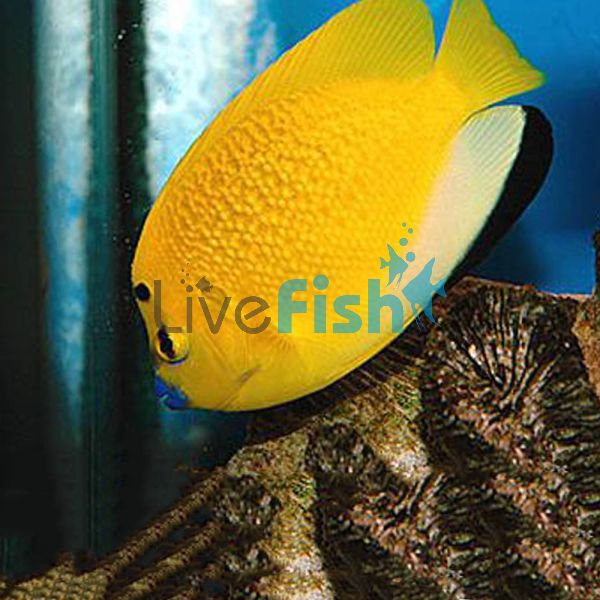Threespot Angelfish - Medium
The Threespot Angelfishes’ bold colour makes it instantly recognizable. These little rays of sunshine in your tank are suitable for experienced aquarists.
Threespot Angelfish
The Threespot Angelfish is bright yellow with blue/purple lips. It gets the name from its selection of spots. The most visible black spot is on its forehead, there is also one above its eye and a lighter one behind the gills. Dorsal and tail fins are both yellow, and the anal fin is slightly paler with black trim.
Distinguishing sex isn't possible as they are not sexually dimorphic. Males may be larger in size. It is possible to breed them in an aquarium environment. Successful reports have come from larger public aquariums. Most home aquariums will be too small for breeding to be successful.
This is an Indo-Pacific species, found in areas such as the Maldives, Indonesia and Fiji. They inhabit lagoons and reef slopes between depths of 3-80 meters.
Tank Recommendations for your Threespot Angelfish
Individual Threespot Angelfish need a tank that is at least 100 gallons (378 litres). This should be increased to 150 gallons (567.8 litres) for a mated pair.
They are more suitable for reefs tanks than other Angelfish but will still need monitoring. This is a preferable option for juveniles as opposed to adults who will eat corals and sponges. A mature tank (at least 6 months) with plenty of algae on the rocks is preferable.
Rockwork should be arranged with plenty of hiding spaces available. A suitable tank will also need a good amount of open space for swimming.
Suitable Tank Buddies
Threespot Angelfish usually have a peaceful temperament. They are best suited to community tanks with docile tank buddies.
They can show aggression to conspecifics or fish with a similar shape or colour.
Usually Compatible
Suitable tank buddies are docile fish such as Fairy Wrasse, Gobies and Dartfish. Invertebrates such as shrimps, snails and crabs are also ok to co-habit.
Sometime Compatible
Threespot Angelfish can only be housed with conspecifics if they are a mated pair. There will be aggression with fish of a similar colour, shape or size.
Rarely Compatible
Dwarf Angelfish will harass Threespot Angelfish, causing them stress and starvation. Avoid aggressive fish such as Damselfish, Dottybacks, 6 & 8 lines Wrasse, Lionfish and Groupers. Large semi-aggressive fish such as Angelfish, Tangs and Wrasse is also a threat.
Feeding your Threespot Angelfish
Threespot Angelfish are omnivores. They consume sponges in the wild and need comparable foods as part of their aquarium diet. Algae is also a large part of their diet. Live rock with plenty of growth can offer this in a tank. Other suitable foods include spirulina and algae sheets. Meaty foods such as chopped fish, enriched brine and mysis shrimp are also suitable. They need feeding several times per day.
| Scientific Name | Apolemichthys trimaculatus |
|---|---|
| Care Level | Hard |
| Common Names | Threespot Angelfish, Flagfin Angelfish, Melas Angelfish. |
| Diet | Omnivore |
| Fish Family | Pomacanthidae |
| Lifespan (years) | 10 |
| Max. Length (cm) | 25 |
| Min. Tank Volume (l) | 378 |
| Origin | Indo-Pacific; - Maldives, Indonesia, Fiji |
| Reef Safe | With Caution |
| Sociability | Semi-aggressive |
| Venomous | No |
| Water Conditions | 23 - 29° C, dKH 8-12, pH 8.0-8.4, sg 1.023-1.025 |




